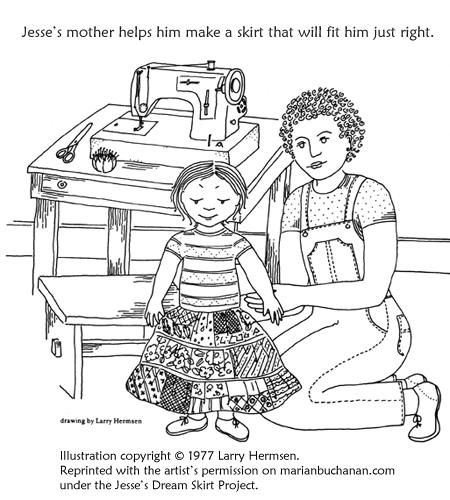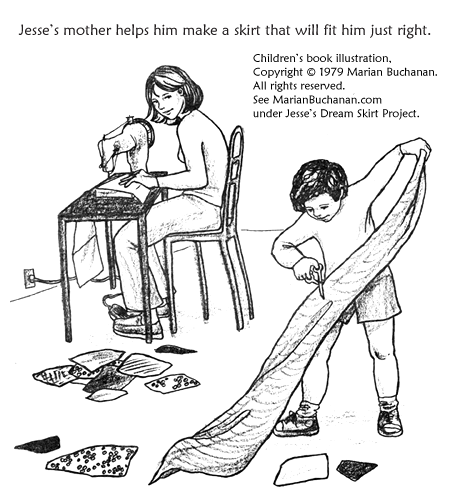 In the children’s story Jesse’s Dream Skirt, the main character is a little boy who likes to wear skirts and dresses – in other words, clothes that the society he lives in considers to be appropriate only for girls.
In the children’s story Jesse’s Dream Skirt, the main character is a little boy who likes to wear skirts and dresses – in other words, clothes that the society he lives in considers to be appropriate only for girls.
We can leave for another time the debate about where such an idea comes from and how arbitrary it is. For now, I just want to look briefly at the issue of how a parent can be supportive of a child whom some would call a “pink boy” — a boy who is “gender non-conforming.”
In Jesse’s Dream Skirt, there are two examples of how to parent a boy who likes to wear skirts, depending on which version of the story you read.
The first thing to know, as background to this part of the story, is that Jesse has tried on his mother’s old dresses but they’re always too big, and he wants “a skirt that would fit well, one that he could wear everywhere he went.” So wearing a skirt to school is his idea, rather than his mother’s, and that’s true for both versions of the story.
When he has a dream about the perfect skirt, full of colors that run into each other when he twirls, he goes straight away to tell his mother about it as soon as he wakes up. In both versions, she smiles as he tells her excitedly about it.
How Jesse’s mother responds beyond that, though, is different from one version to the next. The differences may seem slight, but I see them as significant.
In the original version, published in Magnus magazine, Jesse’s mother starts off by saying, “Follow your dreams,” and she is the one who suggests that, if he likes, she could help him make a skirt like the one in his dream. In the same breath, she warns him (“I must tell you…”) that not everyone will be happy with it and some “will” make fun of him. When he says proudly that he’ll wear his skirt anyway, she hugs him and tells him, “Then you are strong.”

In the book version published by Lollipop Power, it’s in response to Jesse asking if he can have a skirt like the one in his dream that his mother offers to help him make one. Instead of stating that there will be problems, she asks him if he has considered that there might be. She says some of the children “may even” make fun of him. When he says proudly that he’ll wear his skirt anyway, she hugs him and says, “Then we’ll get started on it after breakfast.”

In other words, in the original version the mother is more leading in her support and categorical in her assumptions, whereas in the book version she’s more gently responsive. In the first version there is a clear sense that she approves of her son’s decision, whereas the second version doesn’t bring the mother’s own preferences or agenda into the equation at all.
I think the second version offers a better model of positive parenting. I’m concerned that telling a child they’re “strong” for going against the grain of society’s current conventions, places the child in the position of feeling they may be “weak” (or may be perceived as weak) if they later feel the need to protect themselves, if only temporarily, by conforming after all – hiding who they really are, foregoing the role of iconoclast — for their own sense of social comfort and safety. Accepting and supporting someone means making space for where they’re at at any given point in their process, including any phases that may seem motivated by fear. The concepts of weak and strong are loaded with judgement, with all its potential for guilt and shame, especially in this kind of context where “you’re strong” is intended or perceived as praise. I feel it’s best to leave them out of the picture altogether.
What can we use to replace the double-edged sword of praise? The second version of Jesse’s mother demonstrates the alternative:
She’s allowing Jesse to make his own decision and offering to help him carry it out. She helps him consider the negative possibilities so he can make an informed choice, but presents them as possibilities, not certainties, and thus is not shaping an expectation of the worst case scenario.
Most importantly, since her hug is not given at the same time as praise, it’s more likely to convey love and acceptance that are unconditional on whether she thinks his decision is brave or strong or risky or naïve. It leaves room for him to either stick with his decision or change his mind without losing face, knowing she’ll support him no matter what he decides.
